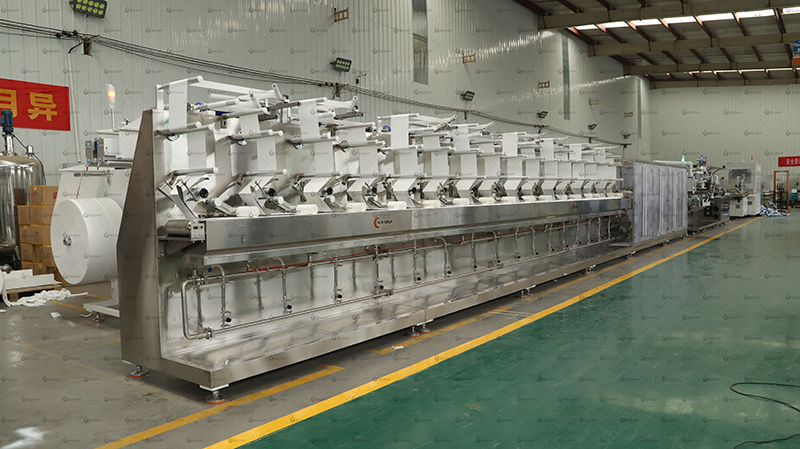In today's fast-paced life, wet wipes have become an indispensable part of our daily lives. Whether it's for personal hygiene, cleaning, or baby care, these convenient pre-moistened towelettes are indispensable. But many people wonder how wet wipes are made? More specifically, how do wet wipe machines make wet wipes? In this article, we'll take you behind the scenes of the wet wipes manufacturing process, explore the steps involved, and answer some common questions about wet wipes machines. By the end, you'll have a clear understanding of how wet wipes are born with the help of wet wipes machines.
1.What is a wet wipe machine?
First of all, we need to understand what a wet wipe machine is. A wet wipe machine is a device specifically designed to produce wet wipes in a highly automated and efficient manner. It is capable of producing wet wipes for different purposes,
such as cleaning, baby care, and medical application wipes. Wet wipe machines are also divided into semi-automatic and fully automatic types, among which fully automatic wet wipe machines are more widely used. Fully automatic wet wipe machines can complete several key steps in the wet wipe manufacturing process, from the preparation of non-woven fabrics to the final packaging of wet wipes, ensuring the quality and hygiene of wet wipes.

2.The Step-by-Step Process of Making Wet Wipes
Step-by-step process of making wet wipes
Nonwoven fabric preparation:
The first step in making wet wipes is to select the right material. Nonwoven fabrics are typically made from polyester or a blend of natural and synthetic fibers and are commonly used in wet wipes. This fabric is chosen for its durability, softness, and ability to retain moisture. The wet wipe machine first unrolls large rolls of nonwoven fabric and ultimately cuts it into individual wipe-sized sheets. The fabric is then processed to ensure that it meets the required standards for strength, softness, and absorbency.
Cutting the fabric into sheets: Once the nonwoven fabric is prepared, the wet wipe machine uses a cutting mechanism to cut the fabric into the desired size and shape. The size may vary depending on the intended use of the wipes (e.g., baby wipes, disinfectant wipes, etc.). The machines are designed to ensure that each sheet is uniform in size and shape, which is critical to ensuring quality and performance.
Moisturizing the Wipes: After the fabric is cut, the next critical step is to moisten the fabric. The wipes are typically soaked with a moisturizing solution, which may include water, preservatives, and various skin-friendly ingredients such as aloe vera, vitamin E, and other beneficial additives. The moisturizing solution may vary depending on the intended use of the wipes. The wipes machine distributes this solution evenly onto the fabric, ensuring that each wipe has the appropriate amount of moisture for its intended use.
Folding and Stacking the Wipes:
After the wipes are moistened, the wipes are folded and stacked into a compact form. The folding process is critical because it ensures that the wipes can be easily pulled out of the package without tearing. Some machines use a Z-fold method to ensure that the wipes are stacked in a way that minimizes waste and maximizes ease of use.
Packaging the Wipes:
Once the wipes are folded and stacked, they are ready to be packaged. The wipes are typically packaged in resealable bags or jars, which help to retain the moisture of the wipes and prevent contamination. The packaging process is automated, and machines seal each package to ensure the wipes remain hygienic and fresh.
Quality Control and Inspections: Before the wipes are ready for shipment, they undergo rigorous quality control inspections. These inspections are to ensure that the wipes meet strict hygiene standards and are free of defects. Machines typically include sensors and cameras to inspect the wipes for any issues, such as improper folding, uneven moisture distribution, or fabric damage.
Wet wipes are a simple yet incredibly useful product, and the technology behind their production is fascinating. Wet wipe machines automate the entire process, from fabric preparation and cutting to moisturizing, folding, and packaging, ensuring efficiency, consistency, and hygiene. As consumer demand for wet wipes continues to increase, manufacturers are continually improving their machines to produce high-quality wipes at a faster rate while also focusing on sustainability. Understanding how wet wipes are made not only allows consumers to choose safer, more reliable wipes, but also allows companies that produce wet wipes to make decisions when purchasing wet wipe machines that are more aligned with their production needs.
Email:ecosanequip@gmail.com
Add: Henan Communication Industry Area, Jingbei 3rd Road, Zhengzhou, Henan, China